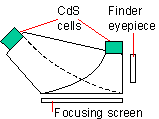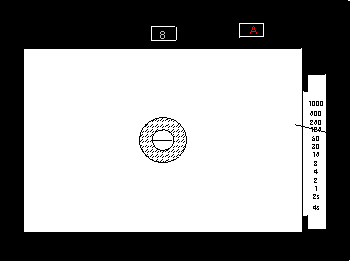Main features

XE-1 with MC W-Rokkor 35mm f1.8 HH
Shutter
 The
XE's shutter is developed exclusively for it and Leica R3 as a co-operation
between Leitz and Copal from Japan, with Minolta adding the experience
it gained in designing the shutter of XM. It is called Copal-Leitz (CLS)
shutter, and unlike the XM's shutter, which is horizontally moving metal
blade shutter made of titanium, it is vertically moving metal focal-plane
shutter with six curtain blades. It is one of the quietest and most precisely
working shutters ever made in 35mm SLR - the Modern Photography called
it "far quieter and jar-free than any [similar] shutter used by anyone
else" (source: Wolf - I could not find
the original). it is hard to believe without having once tried - and then
you might want to hear it again... The Modern Photography August 1976 issue
(p. 119) continues: "...shutter is a marvel of smoothness, light winding
action and quietness compared to most others of its type."
The
XE's shutter is developed exclusively for it and Leica R3 as a co-operation
between Leitz and Copal from Japan, with Minolta adding the experience
it gained in designing the shutter of XM. It is called Copal-Leitz (CLS)
shutter, and unlike the XM's shutter, which is horizontally moving metal
blade shutter made of titanium, it is vertically moving metal focal-plane
shutter with six curtain blades. It is one of the quietest and most precisely
working shutters ever made in 35mm SLR - the Modern Photography called
it "far quieter and jar-free than any [similar] shutter used by anyone
else" (source: Wolf - I could not find
the original). it is hard to believe without having once tried - and then
you might want to hear it again... The Modern Photography August 1976 issue
(p. 119) continues: "...shutter is a marvel of smoothness, light winding
action and quietness compared to most others of its type."
The shutter has electronically controlled speeds from 4 seconds down to 1/1000, with one EV steps in manual mode and steplessly in automatic exposure. In addition it has mechanically controlled X-sync speed of 1/90 and bulb -settings, which work also without battery power. Photo is from Wolf's book.
Metering system
 The
exposure is metered by two cadmium-sulphide (CdS) diodes located in the
pentaprism. They are connected in series and read the exposure on different
areas of the screen, one from the upper and one from the bottom part. The
system is pretty much identical to the system in the AE-finder of the XM.
Also the all manual SR-T series has this type of meter. The reading areas
are overlapping. Because of the series connection the readings of one cell
affect to the readings of the other cell. This is called CLC (Contrast
Light Compensation) system. It is different from normal centerweighted
metering in that it has two centres of metering instead of one, and they
are above and under of the exact centre of the screen. For a user it makes
not so big difference. It gives somewhat better results in certain high-contrast
situations. In my experience, the meter works better in scenics and portraits
containing some bright sky in the background than the centerweighted meters
of XG and XD series. It is, however, by no means foolproof - such a meter
is yet to be invented. You learn the meter similarly you learn any centerweighted
meter, to know what kind of compensation is required in any situation.
The
exposure is metered by two cadmium-sulphide (CdS) diodes located in the
pentaprism. They are connected in series and read the exposure on different
areas of the screen, one from the upper and one from the bottom part. The
system is pretty much identical to the system in the AE-finder of the XM.
Also the all manual SR-T series has this type of meter. The reading areas
are overlapping. Because of the series connection the readings of one cell
affect to the readings of the other cell. This is called CLC (Contrast
Light Compensation) system. It is different from normal centerweighted
metering in that it has two centres of metering instead of one, and they
are above and under of the exact centre of the screen. For a user it makes
not so big difference. It gives somewhat better results in certain high-contrast
situations. In my experience, the meter works better in scenics and portraits
containing some bright sky in the background than the centerweighted meters
of XG and XD series. It is, however, by no means foolproof - such a meter
is yet to be invented. You learn the meter similarly you learn any centerweighted
meter, to know what kind of compensation is required in any situation.
The exposure can be set either manually or using the aperture priority automatic exposure. The viewfinder has a match needle on the shutter speed scale. In automatic exposure mode it shows the shutter speed the camera is going to use at set aperture, in manual mode it tells the shutter speed camera would use - you set the speed you want manually. The XE-1 has SC.. full info viewfinder so it is easy to use in manual mode. The XE-5 has only the match needle with shutter speed scale, so it is less convenient to use.
Viewfinder

The XE-1 viewfinder
The viewfinder is fixed eye level pentaprism. The
focusing screen is fixed and has matte fresnel field with split image and
microprism field in the centre. The screen is of conventional type, not
the Acute Matte screen of later Minoltas like XD and X-700. Therefore a
photographer used to these models might find the XE's viewfinder oddly
dark. The XE-1 has in-built viewfinder shutter to close the viewfinder
when the camera is located on tripod and the photographer's head is not
in front of it. The light from the viewfinder could otherwise affect the
metering.
Multiple exposures
The XE-1 has a separate lever to make multiple exposures into one frame. It is located in front of the film advance lever. To make a double exposure, turn the lever clockwise, then cock the shutter with the film advance lever as usually. The shutter is cocked but nor the film neither the exposure counter does advance. The procedure can be repeated as many times as you want. The XE-5 cannot make multiple exposures.Main switch, film counter and safe load signal
 The
main switch is located beside the film counter. It is easy to use with
your right thumb. When it is ON, everything is on and the camera can make
exposures. This camera really uses battery power all the time the main
switch is ON, so turn it OFF every time you don't use the camera to prevent
battery drain. In OFF position it also locks the shutter release to prevent
accidental releases.
The
main switch is located beside the film counter. It is easy to use with
your right thumb. When it is ON, everything is on and the camera can make
exposures. This camera really uses battery power all the time the main
switch is ON, so turn it OFF every time you don't use the camera to prevent
battery drain. In OFF position it also locks the shutter release to prevent
accidental releases.
The film counter is located below the film advance lever, on the upper edge of the back of the camera. It resets automatically when opening the back. Above it the XE-1 has a special safe load signal (not present in the XE-5), a red plastic bar advancing from left to right in the little window when the film advances. If it does not appear in the left of the window when the film is loaded, remove the film and reload it. The picture shows the place of it (the black slot above the frame counter) but the bar itself is not visible, because there were no film in the camera at the time the photo was taken.
Electricity supply
The meter, shutter and automatic exposure control are controlled by two 1,5 V alkaline cells located in the camera base. At the left end of the body there is a battery check lever. As a backup there are two mechanically controlled shutter speeds available, that work also without batteries. They are marked X (1/90 sec., also X-sync) and B (bulb) in the shutter speed dial.Self timer
The XE has mechanical self timer with delay of app.. 6 to 10 sec. To use it, turn the big lever in front of the camera counter clockwise. To release it, push the little button that normally is behind it.The self timer lever seems to be a weak point of this camera - some broken ones are reported on the mailing lists. Be careful!
Accessories
All Minolta MC, MD and RF lenses, older Minolta lenses with stop-down metering, mechanical cable release, viewfinder accessories (angle finders, loupes, correction lenses), electrical flashes, class FP flashbulbs and lots of close-up accessories. No winder or motor drive, no interchangeable finders or focusing screens.Names of the parts



More about Minolta XE
| My Minolta XE main page | |
| How to use an XE-1 | A short user's manual of XE-1 - not a copy of the original! |
| Technical details | The XE-1 technical data |
| User's comments | E-mailed comments from current and former Minolta users |
My other pages
| Home | My home page. |
| My photos | My photo pages |
| Subjective lens evaluations | of some Minolta's lenses |
| Close-up | About Minolta and close-up photography. |
| Tele lenses | of 300mm length of longer for manual focusing Minolta |
| Links | Yes, links. |